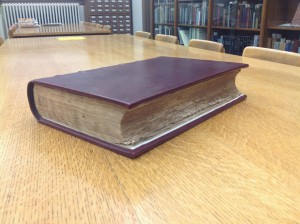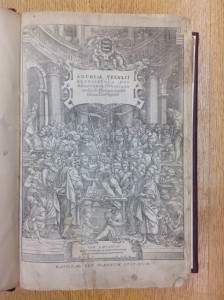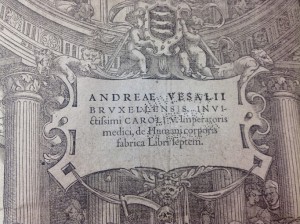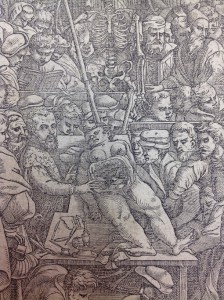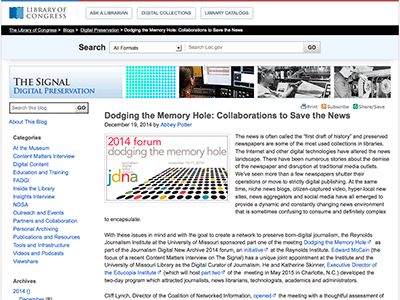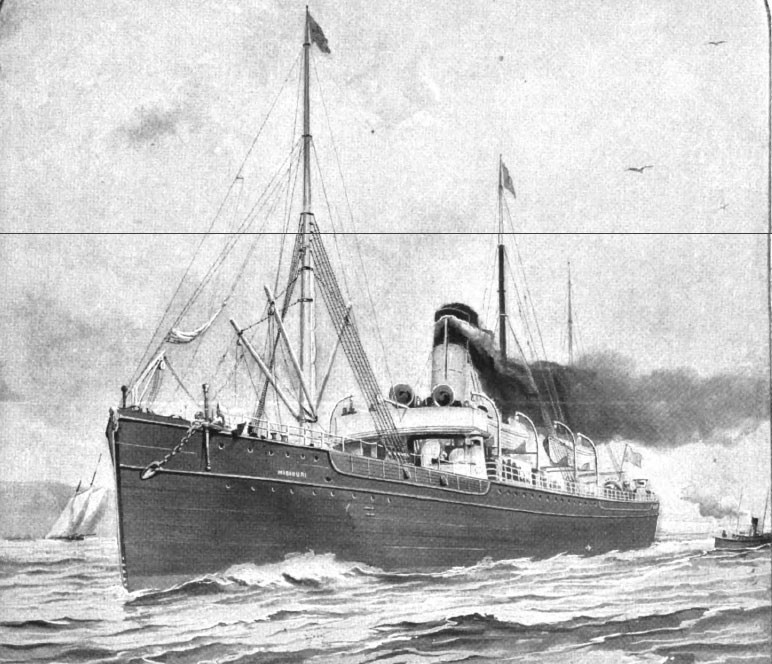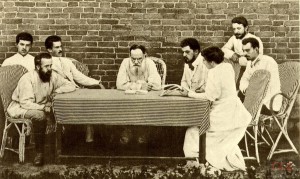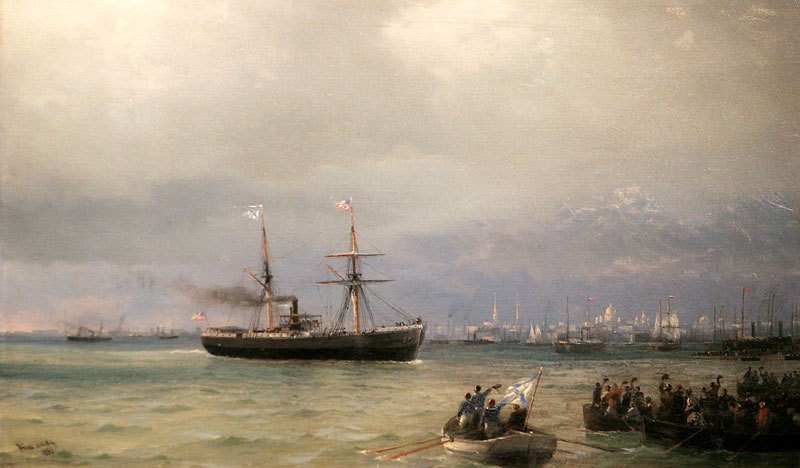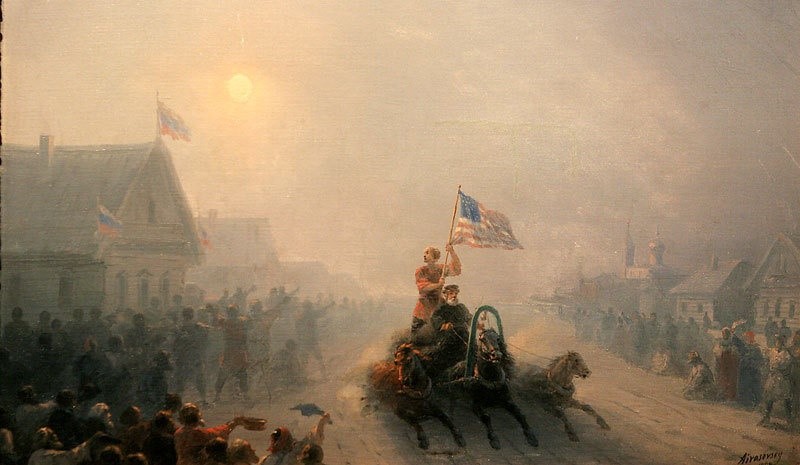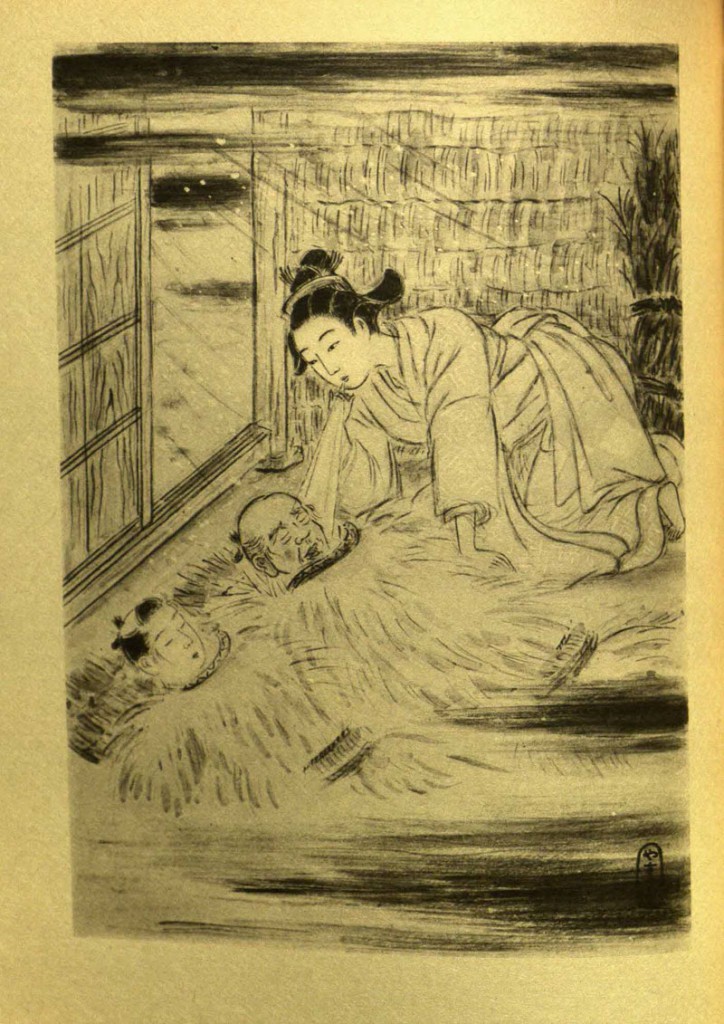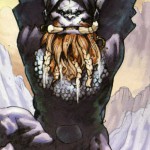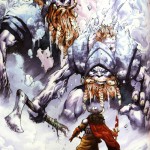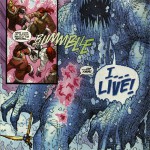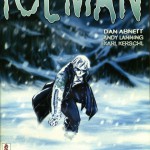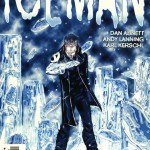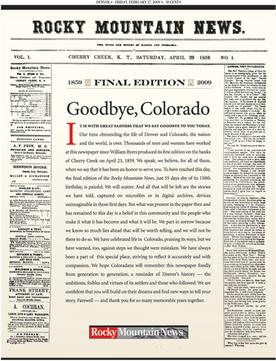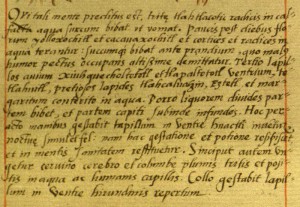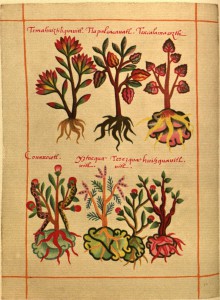Updates regarding mold are listed in reverse chronological order.
May, 2015
Update on remediation of mold-damaged books
The remediation phase of the recovery of mold-damaged books has now been completed with receipt on May 15 of the final shipment of cleaned books back to the Library Depository located in the midway area of Columbia. In total, 451,000 items were shipped to Texas during the past thirteen months for cleaning by two different remediation companies. Treatment of the books required 43 semi-trailer shipments round-trip from Columbia to Texas. A total of 426 pallets were prepared for shipment, with 21,668 boxes packed with books to be cleaned by hand. All 21,668 boxes have now been returned, and the books contained in them await processing.
There is still a much work to be done, but we are pleased to have the books back in the possession of the MU Libraries. We will be working to make the books available for patron use as quickly as possible, but many months are yet needed to complete this final phase of the recovery operation. Special thanks and congratulations are due to Brian Cain, Geoffrey Preckshot and Burt Fields, as well as to the many other library staff and temporary workers who have been assigned to this major project.
January, 2015
Chronology of MU Libraries Mold Incident,
at rented, secondary storage facility (UMLD2), 2013-2014
Executive Summary
On January 24, 2014, an email sent to all MU faculty members confirmed what had been feared three months earlier when the MU Libraries first learned of the mold outbreak. Mold had contaminated the entire collection of over 600,000 printed books and journals stored in a rented storage space located in the Subtera caverns northwest of Columbia. There were only two available options to handle any of the items affected by the mold bloom: disinfecting items to eliminate or to neutralize mold spores, or destroying items so as not to spread mold to other print collections.
Preliminary estimates of the costs to remediate contaminated materials ranged from $2 to $3 per item. It was clear that the most preferred option – to treat all of the affected items – would be prohibitively expensive. At that time, MU Libraries staff resolved to treat as many as 300,000 items, the number that existing funds would likely allow. However, if only half of the contaminated volumes could be salvaged through treatment, the remaining items would necessarily have to be destroyed – a devastating prospect, to say the least.
Library staff began to analyze the affected materials to determine categories of items that should be either salvaged or destroyed. Simultaneously, efforts were underway to raise additional funds to enable treatment of more volumes. Planning began for ways to engage faculty members in the process of selecting materials that should be salvaged, while at the same time, duplicate items and easily replaceable materials (e.g., government documents) were made ready for destruction.
On February 10, 2014, the first duplicate items were sent for destruction, eventually to be buried in a landfill. It is important to note that the MU Libraries regularly discard books and other items from our collections, according to long-standing policies. Ordinarily, permanently discarded copies are not destroyed but rather placed in the Ellis Library Book Sale or sent to such agencies as Better World Books, which distributes useable books to schools and other agencies. The Libraries rarely destroy books, but every year some items from our collections are damaged by such things as beverage spills, insect infestation, and occasional mutilation by library users. In these cases, materials are routinely destroyed, and library selectors are alerted to the possible need for replacement copies.
Our analysis of affected materials identified an initial 300,000 items for treatment (a total of 303,000 were eventually sent), and another 138,000 items that were not duplicated elsewhere in the library collections of either MU or the other UM campus libraries. Approximately 188,000 contaminated items remained, consisting of some 80,000 copies of books and journals (duplicated in either print or online form), and another 108,000 federal government documents (readily replaceable from the collections of area libraries). The 138,000 non-duplicated items were set aside in the expectation that faculty members would assist library staff in determining those to be salvaged and those to be destroyed.
Beginning in May, 2014, the bleak prospects of the previous months were replaced by good news. A new, clean facility to store treated materials was leased, and preparations for occupancy began. The UM Procurement Office negotiated from our preservation contractor a favorable mold remediation cost of $1.43 per item. Then in June, the Andrew W. Mellon Foundation awarded a $400,000 grant to help with costs of recovery. This was the best possible news for library staff, because it meant there was no longer a need to determine what items of the 138,000 total should be salvaged. The grant funding would enable treatment of all the remaining 138,000 books being held for decision.
On October 20, the final shipment of contaminated duplicate items was sent for disposal, and no further destruction of any other materials was necessary. Because all of the approximately 188,000 items destroyed were duplicated or (in the case of federal documents) were being replaced, no scholarly content had been lost from the mold outbreak. In the end, the disposition of the contaminated materials, from October, 2013, through December, 2014, was as follows:
|
Items salvaged via remediation (treatment by contractor)
|
441,000 items (70%)
|
|
Federal documents destroyed (replaced by copies from other libraries)
|
108,000 items (17%)
|
|
Law, medical and veterinary journals destroyed (online copies available)
|
33,000 items (5%)
|
|
Duplicate book copies destroyed (print copies available)
|
25,000 items (4%)
|
|
Duplicate journal copies destroyed (print copies available)
|
22,000 items (3%)
|
|
TOTAL:
|
629,000 items
|
The cost of recovery from the mold outbreak continues, but the following is an accounting of the expenditures from October, 2013 through December, 2014:
|
MU Libraries Insurance Reserve Funds
|
$580,000
|
|
Mellon Grant Funds (July-Dec., 2014)
|
$254,000
|
|
TOTAL:
|
$834,000
|
Chronology, September, 2013 to December, 2014
September, 2013
9/20/13 – First indication of high humidity and temperature readings noted in UMLD2. Investigations by June DeWeese, Michaelle Dorsey, Ann Riley and James Keyser-Andre ensue.
October, 2013
10/11/13 – Mold noticed on item retrieved from UMLD2 by Physical Processing staff in Ellis Library; Jim Cogswell alerted; Jackie Blonigen and Michaelle Dorsey visit storage facility and take pictures, accompanied by UMLD supervisor, James Keyser-Andre.
10/15/13 – Belfor Property Restoration Services contacted to conduct preliminary on-site analysis of mold infestation.
10/17/13 – Provost and Chancellor’s office alerted to presence of mold in UMLD2.
10/18/13 – MU Libraries subject specialists meeting at Ellis Library includes discussion of mold.
10/25/13 – MU Libraries initiate discussion with Business Services concerning requirements for likely selection of new storage site.
10/29/13 – MOBIUS and other partner libraries notified of mold presence in UMLD2.
10/30/13 – MU Environmental Health and Safety (EHS) inspection and report requested.
10/31/13 – Notice of non-renewal of Subtera contract (UMLD2 lease) sent to Business Services.
Library staff members initiate study of holdings at UMLD2 to determine unique or rarely-held materials; consultations begin with OCLC to assist in collection analysis, and with Hathi Trust to obtain digital access to materials if needed.
November, 2013
11/1/13 – Plans made to leave UMLD2 (Subtera caverns) by June 30 to avoid possible further exposure to summer heat and humidity.
11/4/13 – Initial press release issued to MU News Bureau and campus offices, announcing presence of mold in UMLD2.
December, 2013
12/2/13 – Library Committee members given detailed report on mold situation at monthly meeting. Updates on mold recovery efforts are presented at subsequent meetings of the Library Committee.
12/19/13 – Library of Congress Head of Preservation Directorate consulted.
Work continues to identify possible unique or irreplaceable contaminated items.
January, 2014
1/1/14 – Brian Cain from Ellis Library Technical Services begins assignment to oversee the two storage depositories. (Brian had worked in UMLD1 and UMLD2 for seven years before coming to Ellis.)
1/22/14 – MU Environmental Health & Safety (EHS) report received concerning type of mold and extent of contamination. ALL materials at location are confirmed to be contaminated with Cladosporium and Penicillium/Aspergillus. All materials currently in UMLD2 must either be decontaminated or be destroyed to prevent further spread of mold.
1/24/14 – Announcement to MU campus faculty issued about the mold situation, stating in part: “…the entire collection of approximately 600,000 printed volumes in the storage facility is contaminated and must either be treated to eradicate the mold or be destroyed…. We expect to remediate and to keep in our collections up to 300,000 volumes from the contaminated materials.”
1/30/14 – Chronicle of Higher Education news item on MU Libraries mold outbreak appears.
1/30/14 – New contract with Subtera issued, extending lease until June 30, 2014 (original lease had been due to expire as of 02/01/14).
1/31/14 – Email received from The Andrew W. Mellon Foundation concerning the mold situation; Program Officer, Donald Waters, asks if the Foundation may be able to assist.
February, 2014
2/7/14 – “FAQ Regarding Mold at Offsite Storage” is posted on library website: http://library.missouri.edu/announcements/14/12/29/faq-regarding-mold-at-offsite-storage-2/. The FAQ, which has been updated periodically, includes a brief description of the mold outbreak, the disposition of materials affected, and information regarding resources to carry out treatment and storage. The FAQ page also describes the issues related to the rented storage space, and the plan to build an addition to the original depository (UMLD1), which remains mold-free.
2/10/14 – Disposal of UMLD2 materials identified as duplicates begins, according to existing library collection management policies. Initial materials sent for destruction include: journals from Health Sciences and Veterinary Medical libraries (duplicated online); Law Library journals (duplicated online); U.S. government documents (replaceable via copies from area libraries); duplicates of print materials available in Columbia locations; and items judged to be unsalvageable (damaged beyond recovery). Library selectors are notified about unsalvageable items in case replacement copies must be obtained.
2/11/14 – Outline of proposal submitted to Mellon Foundation for review. Foundation requests submission of full proposal by March 14, 2014, for Board review and decision at June meeting.
2/21/14 – RFP for remediation of approximately 300,000 contaminated items is issued by Procurement Services for contractor bids. This is the estimated number of items that can be remediated with available funding. Some 138,000 other contaminated items have been withheld for future decision, pending possible new funding from additional sources. If sufficient new funding is not available, review by faculty will be required to salvage any of these items.
2/27/14 – Jim Cogswell and Matt Gaunt meet with Faculty Council, at the Council’s request, to report on the mold situation. Due to lack of funds, only 300,000 items will be treated immediately, starting with areas of collection strength, and with unique or scarcely-held items. Libraries are reviewing ways in which faculty may be able to review lists of items not yet chosen for remediation, probably via a website. Campus Facilities is working to secure a new storage space so that we can vacate the current caverns by June 30. A grant application to a major private foundation is being prepared. There is a need to revive a UM System plan to build an addition to the existing purpose-built book depository, which has remained mold-free since opening in 1997. The MU Libraries’ overarching goal is to ensure that no student or faculty member will lose access to any of the scholarly content contained in our collections.
Collection Enhancement Fund is created to accept cash gifts received in response to news about mold recovery efforts. Initial goal of the fund is $50,000. Information available via the MU Libraries website:
https://donatetomu.missouri.edu/givedirect/GDItem.aspx?item_id=117
March, 2014
3/5/14 – Second draft of grant proposal submitted to Mellon Foundation for review.
3/12/14 – Third and final draft submitted to Mellon Foundation and accepted. Mellon requests final electronic and print copies, with endorsement letters, by 3/21/14.
3/14/14 – Jim Cogswell and Ann Riley meet with Faculty Council Ad-Hoc Subcommittee on Mold at Subcommittee request. Ann informs group that the library disposes of materials according to existing policies “all the time.” Subcommittee asks to be able to review lists of materials to be permanently discarded. Subcommittee members are told such lists could be made available in the fall. Main concern of members appears to be loss of access to the content of physical books. Some indicate they do not consider electronic copies acceptable substitutes for print.
3/19/14 – Final Mellon grant application submitted; print copy delivered by FedEx on 3/20/14.
April, 2014
4/3/14 – Press release issued (and FAQ webpage updated) on the mold situation. Plan for disposition of contaminated materials includes three categories to guide decisions on remediation versus destruction. Category 1 includes examples of materials that will be treated and retained for library collections. In this category, some 300,000 items have been set aside, awaiting treatment by the mold-remediation contractor. Category 2 includes “multiple copies or readily accessible items that may be withdrawn permanently.” Category 3 includes items awaiting decision either to decontaminate or to destroy, depending on available funding. Approximately 138,000 items are in this third category and are held awaiting decision as to final disposition.
4/4/14 – Contract for mold remediation on first 300,000 contaminated items issued to Belfor Property Restoration. Seven bids were received in response to the February RFP.
4/23/14 – First load of contaminated materials to be cleaned is shipped out to Belfor processing facility in Ft. Worth, Texas.
May, 2014
5/1/14 – New UMLD2 facility lease (secured on 4/29/14 by Business Services and Campus Facilities) goes into effect. New facility begins to be made ready with segregated areas to isolate contaminated from newly-treated materials.
June, 2014
6/3/14 – Last truck of initial items of contaminated materials leaves for Belfor to be cleaned. (Total shipment included 302,944 books in 13,919 boxes on 264 pallets.) Remaining 138,000 contaminated items, along with shelving and equipment from caverns, removed to new storage facility to await disposition. Move to new facility completed on 6/20/14.
6/6/14 – Email received from Mellon Foundation informally announcing the success of the grant proposal.
6/18/14 – Mellon grant proposal letter and check arrives in Office of MU Chancellor. The grant award will enable remediation of the remaining 138,000 contaminated items set aside for deferred decision, as noted in the press release issued on 4/3/14.
6/29/14 – UMLD2 (Subtera caverns facility) vacated of all materials and equipment.
July, 2014
7/1/14 – Mellon grant funds begin being expended according to work plan.
7/9/14 – Receipt of Mellon grant announced. http://library.missouri.edu/announcements/2014/07/09/the-mu-libraries-receive-funding-from-andrew-w-mellon-foundation-for-recovery-of-materials-damaged-by-mold/
September, 2014
9/4/14 – Construction of modifications for new UMLD2 facility completed. These include the clean/dirty dividing wall, sprinkler installations, electrical and lighting modifications. Shelving for new UMLD2 leased facility is cleaned and installed in storage area, awaiting newly-treated materials from Belfor.
9/22/14 – First shipment of cleaned books returned from Belfor arrive at new UMLD2 facility.
9/30/14 – Work begins to secure second contract for mold remediation on remaining 138,000 contaminated items, now able to be treated with funding from the Mellon Foundation. These additional funds have made it unnecessary to destroy any materials other than duplicated items or books damaged beyond repair.
October, 2014
10/20/14 – The final shipment of items contaminated by mold in the Subtera caverns is sent for disposal. No content has been lost from any of the items destroyed in the process of dealing with the mold contamination. Instead, that content has remained available in one or more of the following ways: via duplicate copy (in print or online), via replacement from partner libraries (for government documents), or via purchase (when deemed necessary).
10/24-28/14 – Initial shipments of replacement volumes of government documents received from partner libraries, Washington University-St. Louis (Wash U) and Missouri State University (MSU). Total of seven pallets of boxes received from Wash U, and five pallets of boxes received from MSU, at new UMLD2 facility.
10/30/14 – Library Committee and Faculty Ad-hoc Committee members receive clarification on mold recovery. No materials, other than duplicate copies or items replaced with clean copies, have been destroyed. The discarded print materials included some 108K US Federal government documents currently being replaced by print copies from partner libraries; 47K duplicates of print copies held in other collections maintained by MU Libraries; and 33K duplicates of online journals designated by staff from the Health Sciences Libraries and the Law Library on the MU campus.
November, 2014
11/11/14 – Nine pallets of boxes containing replacement documents received from Wash U.
11/18/14 – Last of the initial June shipment of 303,000 decontaminated items returned from Belfor to the new storage facility. Processing and inspection of the items begins.
11/25/14 – Nine more pallets of boxes containing replacement documents received from Wash U.
December, 2014
12/2/14 – Jim Cogswell sends email via Faculty Council detailing the progress in handling the mold situation. (Text of email appears in FAQ page noted above.)
12/17/14 – Five pallets of boxes containing replacement documents received from MSU. Additional shipments of documents from both Wash U. and MSU libraries expected in January, 2015.
Conclusion
The mold bloom discovered in October, 2013, was the second major disaster to strike the MU Libraries in three years. In September, 2011, an arson attack on Ellis Library was a monumental disruption that lasted well into the following academic year. The mold outbreak has also been a major disruption, with current costs now approaching $1 million, and with added workloads severely straining a diminished library staff.
However, as devastating as the mold disaster has been, it is by no means the biggest challenge facing the MU Libraries. A far more serious issue is the continued low level of funding that has undermined the quality of MU Libraries collections, services and facilities for many years. Without additional funding, a secure, long-term storage solution for our physical book and journal collections cannot be implemented. Our best strategy to accomplish this goal is to build an addition to the primary UMLD storage facility – an addition planned during the original construction in 1997, but never executed. The first step toward realizing this option, estimated to cost at least $5 million, is to return the UMLD addition to the priority list for capital projects. We are actively working to implement this strategy.
Jim Cogswell
Director of Libraries
January 20, 2015
December, 2014
Email to MU Faculty, regarding disposition of mold-infested library materials.
It has been just over one year since we learned of the disastrous mold outbreak in the MU Libraries’ off-campus, rented storage facility. From October of last year through May, there was no good news to report. More than 600,000 printed books and journals were infested, and our initial cost estimates suggested that we could afford to salvage only about half that number. We needed a plan to determine what volumes to salvage, how best to clean those materials, and where to store the volumes after treatment. What’s more, that plan had to be implemented very quickly.
Since May, the news has been much better. We secured a new, clean facility to store materials treated for mold. The UM Procurement Office negotiated from our preservation contractor a lower-than-anticipated cost for the mold remediation. In June, the Andrew W. Mellon Foundation awarded a $400,000 grant to help with costs. Beginning in September, replacement copies of those U.S. Federal documents contaminated by the mold began arriving from our partners in the mold remediation effort, Missouri State University and Washington University in St. Louis.
I am now happy to report that no content has been lost from the 629,000 copies of print materials contaminated by the mold bloom. The disposition of the affected print materials (in rounded numbers) is as follows:
441,000 items salvaged via treatment by Belfor, and now being returned to MU Libraries locations
108,000 federal documents replaced by copies from partner libraries (Wash U. and MSU)
33,000 law, medical and veterinary medical volumes destroyed (electronic copy available online)
25,000 duplicate book copies destroyed (print copy available in MU library or UMLD locations)
22,000 duplicate journal copies (from 2,700 titles) destroyed (print available, MU Library or UMLD)
Information on copies destroyed due to duplication in print elsewhere in MU Libraries collections is available for download here: https://libraryguides.missouri.edu/staff/umld2. Note that information on materials from the Law, Health Sciences and Veterinary Medical Libraries are available on request.
Since September, shipments of treated volumes have been arriving in the new storage facility. On November 18, the 300,000th copy arrived for processing and shelving, and another 138,000 volumes are due to arrive in the coming months. Each treated item is being checked to ensure that mold is no longer present, and cataloging records are being updated to enhance access. All salvaged books are expected to be fully available for use by late spring of 2015. Please contact your subject librarian liaison for further information.
Thank you sincerely for your continued support of the MU Libraries during this difficult period.
Jim Cogswell
Director of Libraries
July, 2014
The MU Libraries Receive Funding from Andrew W. Mellon Foundation for Recovery of Materials Damaged by Mold
COLUMBIA, Mo.− The University of Missouri (MU) Libraries have received $400,000 from the Andrew W. Mellon Foundation to support remediation or content replacement of materials damaged by an extensive mold outbreak in an off-site storage facility. This outbreak, discovered in October 2013, is presumed to have contaminated all of the approximately 600,000 volumes housed in that facility.
Partnerships with Washington University in St. Louis (WUSTL) and Missouri State University (MSU) will provide access to replacement copies of federal government documents and inter-library loan access to Missouri state materials, respectively. Subcontracts with these universities through this project will support the cataloguing, retrieving and preparing of relevant materials to share with MU Libraries on an as-needed basis. The funding also will help MU review the availability of online or print-ready copies of needed replacements through cooperation with membership organizations. WUSTL will benefit by regaining space vacated by federal documents transferred to MU, while MSU will benefit by having its Missouri state materials catalogued in order to provide access to MU and other area libraries.
“The MU Libraries are deeply grateful to the Mellon Foundation for their support of this project that leverages tools of digital librarianship to help preserve scholarship in traditional formats,” said MU Libraries Director Jim Cogswell. “Institutional partnerships will enable the preservation of regional documents collections. The Mellon Foundation funding will allow MU Libraries to remediate mold for key groups of materials, work effectively with partner institutions for resource sharing, provide continued access to needed content of the damaged materials, and support part of the recovery effort.”
MU Libraries also will spend up to $600,000 from a self-insurance fund; additional sources are being explored. MU Libraries has contracted with a company for remediation services and negotiated for rental of two storage spaces, one in which pre-treated materials will be stored until they are cleaned, and one for storage of the remediated materials. As a longer-term solution, the Libraries are working with University of Missouri (UM) System's risk and insurance management department to develop a new strategy for fully insuring all collections, including those in storage, and will work with campus and UM System leadership to restore a plan for building an expansion to an existing storage facility and to accelerate fund allocation for its construction.
May, 2014
New Offsite Storage Facility for MU Libraries
The MU Libraries has selected a new temporary storage facility for the materials that were stored in the UMLD2 (Subtera) storage facility at the time of the mold outbreak. The lease for this new facility began on May 1, and is renewable annually for five years unless another agreement is made before that.
Books held there or at our other storage facility must be requested through the libraries or our online catalog, to be picked up on campus or in the case of many journal articles, for electronic delivery, usually within 48 hours and often more quickly. The new facility will not be fully operational until later this summer, but the libraries are fulfilling requests for items through interlibrary loans.
The climate controls at this facility are superior to those at the previous facility. This facility has heating, ventilation, air conditioning and cooling that meet library preservation standards.
April, 2014
MU Libraries, Mold Update
Background
In October 2013, MU Libraries staff members discovered mold growing on books and bound journals in the Libraries’ secondary offsite book depository, in underground caverns north of I-70 in Columbia. The mold growth likely occurred due to inappropriate environmental conditions, specifically a spike in both temperature and humidity in July and August. A private environmental recovery company was retained to investigate, and they reported that the entire collection of some 600,000 volumes is presumed to be contaminated.
Because mold is destructive to printed materials, any volumes to be retained for use in the library collections must be treated to remove the mold before they can be used. Over the past several months, library staff members have been determining what portions of the contaminated volumes should be treated and retained and what portions must be permanently withdrawn and destroyed in order to remove any chance of contaminating other collections of print materials.
In order to meet the considerable costs involved in addressing this disaster, the MU Libraries will be using a special insurance fund established eight years ago to deal with such losses. However, estimates to decontaminate the collections, and to obtain new and more secure storage for materials retained for use, amount to far more than the current total on hand in the fund. With special insurance funding and potential added revenues from gifts and grants, the MU Libraries expect that approximately 400,000 volumes will be salvaged from the total volumes contaminated by mold.
Disposition of Collections
MU Libraries staff have identified three broad categories of materials to guide decisions in prioritizing items either for mold remediation or for permanent withdrawal from our collections. It is important to note that these categories are tools for informing decisions, rather than prescriptions for identifying items for either treatment or destruction. Likewise, examples listed are intended as illustrations of what kinds of materials will be considered for a given category, not rigid rules that will govern final disposition.
Category 1 – rare, distinctive and scarcely-held items to be treated and retained.
Examples in this category include:
· Materials published prior to 1871
· Materials that have unique characteristics or that form part of a distinctive collection
· Materials that have local significance or value
· Materials held by 10 or fewer libraries worldwide (as determined by OCLC analysis)
· Materials with distinctive characteristics (e.g., non-English language works; graphic arts, illustrations or photographs; mathematical formulae; etc.)
Category 2 – multiple copies or readily accessible items that may be withdrawn permanently.
Examples in this category include:
· Materials duplicated elsewhere in the MU Libraries, or in UM Library Depository.
· Materials duplicated at one or more of the other three UM System libraries.
· Materials duplicated within the MOBIUS consortium of Missouri libraries.
· Materials not in MOBIUS, but readily available via interlibrary loan from Greater Western Library Alliance (GWLA) and other regional partners.
· Materials duplicated electronically in trusted digital repositories of academic journals and books (e.g., JSTOR, Hathi Trust, etc.)
· Federal documents published post-1950. (Other libraries in the state have generously offered to replace mold-damaged copies with documents from their collections.)
Category 3 – decision deferred until more information is gathered and consultation is completed.
Materials not immediately placed into categories 1 or 2 will be retained until final decisions can be made either to retain or to withdraw permanently. We will be leasing a new space in which to hold these volumes while awaiting final decisions on their disposition. Because we are committed to having MU faculty assist in selecting materials to be salvaged and retained for our collections, having this holding space is essential.
Recent Developments
The MU Libraries have received many expressions of sympathy and support since news of the mold outbreak was released. A special fund has been established to assist in salvaging the thousands of books and journals that require special treatment to eradicate the mold, and a challenge gift of $5,000 has been offered by an anonymous donor to match any donations up to that amount. Individuals can contribute to the “Collection Enhancement Fund” via the MU Libraries website:
https://donatetomu.missouri.edu/givedirect/GDItem.aspx?item_id=117
In March, a proposal was submitted to a major private foundation seeking grant funding to pursue the plan to remediate contaminated volumes. We expect to learn in early June whether the proposal is accepted, and if so, the funding will begin July 1.
With guidance and approval from MU Facilities Planning and the UM Procurement Office, steps have been taken to obtain a contractor for treatment of volumes identified for salvage and to secure new and environmentally stable storage space for treated materials.
Proposals from mold-remediation contractors were solicited over the past two months, and seven bids were received on March 14. A preferred bidder has been identified and negotiations are now underway with the contractor. We expect to have a contract signed on or about April 1, with work to commence by the middle of the month.
After a search for suitable above-ground storage facilities in close proximity to the MU campus, three potential sites were selected for further review. From these, a preferred facility has been selected and negotiations for a lease are nearing completion. The new rental facility is above-ground, and the lease specifically addresses the need for stable climate control. We expect to have the lease signed soon and preparations underway to take occupancy on or about May 1.
Future Plans
This disaster has underscored the need to pursue purpose-built, environmentally secure space for long-term storage of our physical collections. Since 1997, the UM Library Depository (UMLD), the primary storage facility used by MU and the three other libraries of the UM System, has worked flawlessly in this capacity. Located on LeMone Blvd., off Highway 63 in Columbia, the UMLD contains about 1.2 million print volumes, which are used by the four UM campuses and are also available to all libraries in the state via the MOBIUS network. The facility was designed to accommodate an addition which would double the space of the original structure when it reached its maximum limit. Approaching that limit in 2006, a request was made to the UM academic officers to consider funding the UMLD addition, but that option was deemed to be cost-prohibitive. Instead, leased storage space was judged to be the preferred course of action.
The MU Libraries proposes to work actively with the campus administration to return the construction of the UMLD addition to the priority list for capital projects. The MU Faculty Council and the Library Committee have both expressed support for this option, and it is our hope that this request will be put before the University Board of Curators early in the new fiscal year.
Submitted by Jim Cogswell, Director of Libraries
April 3, 2014
February, 2014
Frequently Asked Questions
To our students, faculty, alumni and friends:
Thank you for the many e-mails and phone calls expressing concern for the mold situation currently facing MU Libraries. No one cares more about preserving knowledge and scholarship than our librarians and library staff. As we work through our plan to treat, to relocate and sadly, to discard various portions of the collection, please know that we are making every effort to save items with special value and to retain ready access to information in the collection. We welcome your input and encourage you to contact our communications officer, Shannon Cary,carysn@missouri.edu, if you have questions that are not answered below.
How Can I Help?
To assist with MU Libraries' response to the mold bloom, we have established the Collection Enhancement Fund.Your gift will be used to treat, relocate and in some cases, replace items impacted by mold. Our goal is to ensure that MU Libraries' ability to serve the needs of our users is not compromised by this sad event. A gift of any amountis greatly appreciated!
What portion of the collection has been exposed to mold?
Roughly 600,000 books, or just under 20% of MU’s collection has been exposed to mold.
The University of Missouri Libraries use two offsite storage facilities for library materials in addition to the on campus libraries. Both offsite facilities use size-based high density storage (“Harvard Model”). One of the facilities, referred to as UMLD (UM Library Depository) is a purpose-built storage structure owned by the University System. Built in 1997, it is located in an industrial office park on Lemone Industrial Blvd. in southeast Columbia. It holds about 1.2 million volumes, from all four UM campus libraries. The current second depository, referred to as UMLD2, is a rented underground space in northwest Columbia. It holds about 600,000 volumes from the MU campus only.
In October, 2013, mold was discovered growing on bound journal volumes and books throughout the UMLD2 facility. The damaged collections cover a broad range of subjects, and all belong to MU Libraries.
-
Approximately 64,000 volumes are from the Law Library, consisting of mostly pre-1980 bound journals.
-
Approximately 30,000 volumes are from the Engineering Library, both older monographs and pre-1990 bound journals.
-
Approximately 47,000 items are from the Health Sciences Library, and 9,700 are from Veterinary Medical Library.
-
Remaining items (over 250,000) are from Ellis Library and are infrequently used monographs, federal and state documents, or pre-1990 bound journals replicated in online sources.
-
Approximately 124,000 US documents.
-
A smaller number of items are from the Geology, Journalism and Math Libraries
Should all of the books, journals and documents be saved?
Much of the content of the damaged collections is duplicated via online sources, in UMLD, or in other MOBIUS libraries and groups with which MU has partnerships. Reducing the size of the collection from UMLD2 is required to decrease both mold clean-up costs and long-term storage needs. MU Libraries staff have been identifying strategies for retention and remediation to allow preservation of collections with unique or special content.
Who is making decisions regarding which books will be saved?
All decisions regarding treatment, relocation and removal of books and journals from the collection are the responsibility of the MU Libraries administration. MU Libraries staff are working with campus faculty and staff to gather information critical to the decision making process. MU Libraries staff are also consulting with outside experts from the Library of Congress and the American Institute for Conservation – Collections Emergency Response Team.
Can people come and take books that are to be destroyed?
We appreciate the well-meaning intentions of those that have offered to take in moldy books, however, we have been advised by preservation staff at the Library of Congress that the best way to deal with contaminated books that will not be treated and returned for use in our collections is to destroy them so that they cannot contaminate ours or other collections.
Can volunteers help clean the books?
Again, we appreciate all the offers of assistance, but the MU Libraries are currently working with MU’s Department of Environmental Health and Safety and Procurement Systems Office to identify the professional services needed to handle these materials in the appropriate manner.
Were the books insured?
Yes, limited insurance funds are available. In 2006, a “special insurance fund” was created to cover the books at the off-site storage facilities and portions of the books in our branch libraries. That fund currently has a balance of $872,000.
Prior to 1979 MU’s collection was not insured at all. From 1979 to 2006 the collection was fully insured. In 2006, with inflationary cost increases pushing the cost of full insurance over $350,000 per year, MU Libraries proposed a plan that would save over $200,000 a year. Half the savings each year was reallocated to academic programming and half was invested in an interest-bearing fund to be used if we suffered a catastrophic loss. Under this plan all bound journals and books in Ellis Library, as well as rare books at Ellis Library and the Health Sciences Library, were fully covered.
Is this a common approach for insuring university collections at other institutions?
There is no uniformity as to how, or whether, universities across the country insure their library collections. At the time of our insurance evaluation in 2006, we found that some state universities with prestigious collections, such as the University of Illinois, relied totally upon state dollars should a catastrophic loss occur. Others chose to fully insure as we had done in the past. Our approach of full insurance for a portion of the collection and a special insurance fund for a portion of the collection, fully protects our most valuable volumes while providing some coverage for the remaining collection. The logic of this approach was further validated by the fact that portions of the collection covered only by our special insurance fund might not be replaced after a loss due to the rise in availability through interlibrary loan, existing duplication, and availability in electronic format.
How will this impact MU Libraries collection?
Our goal is to retain access to all of the scholarly materials that have been impacted by the mold bloom. There will be a loss of a great number of volumes from our physical collection, but we hope to retain access through interlibrary loan and electronic formats. All items determined to have special value will be treated and relocated.
What is the plan to provide a proper offsite library depository?
The MU Libraries have been planning for an addition to UMLD since 1998. Plans have been updated regularly to account for increased costs for construction, as well as increased demand, changes in bond rates, annex rental rates, and other factors. The estimated cost of construction in 1998 was $2,673,500, and in 2005, we estimated construction costs at $3,965,782. In 2007, when the UM System again declined our request to build a proper facility, the cost was estimated to be $4,230,534. Today we are looking at costs over $5,000,000.
The UMLD2 facility is the third annex facility MU Libraries has utilized since reaching capacity at UMLD. Despite the recent mold problems, it is a step above the two previous facilities. A lack of funding for a proper depository has driven decision-making regarding the offsite storage of books. MU Libraries is hopeful that our current mold issue will generate interest in our plans for an addition to UMLD. We are also working with the other UM System campuses to create additional space in UMLD, and hope to have a home for between 100,000 and 200,000 additional books by the summer.
January 2014
To University of Missouri Faculty:
In October, MU Libraries staff members discovered signs of active mold growth on books and bound journals located in the second of our two offsite library storage facilities – the one located in caverns north of I-70 in Columbia. I immediately reported the issue to the Provost, the Chancellor and Campus Facilities. The campus Library Committee has also been consulted at length about the problem. Over the past several weeks, MU Libraries staff members have been working to identify the extent of the infestation and to begin addressing the problem with the help of a commercial remediation company.
We have learned that the entire collection of approximately 600,000 printed volumes in the storage facility is contaminated and must either be treated to eradicate the mold or be destroyed to ensure that contamination cannot spread to other collections. Treatment cost is currently estimated at about three dollars per volume, which means that the expense of treating all affected items could reach $1.8 million. The MU Libraries have built a self-insurance fund to deal with such disasters, but the amount currently in the fund is less than one-half this total estimated cost.
At present, we are identifying those materials that are most readily accessible to our users either online or via Interlibrary Loan so that we can focus our limited self-insurance funds on treating and retaining materials that are unique, of special value, or held by few libraries within the region or nationally. In addition to financial concerns, we are working under extreme time constraints. Affected materials must be dealt with quickly and removed to environmentally secure storage before warm weather and humidity returns. We are currently seeking new storage options, and we intend to move all treated materials before the end of June. For this reason, our review of contaminated materials has already commenced. In order to meet our June deadline, we will need to treat and relocate at least 15,000 volumes each week. We expect to remediate and to keep in our collections up to 300,000 volumes from the contaminated materials.
As you can imagine, MU librarians and staff are deeply concerned about this situation. While our first instinct is to preserve all of the mold-damaged materials, treating and retaining every volume is simply not possible under our current circumstances. This process is extremely painful for everyone, and we hope that we will receive the understanding and support of the entire MU community as we undertake the difficult decisions and tasks confronting us.
Sincerely,
Jim Cogswell
Director of Libraries
Posted via email to MU faculty on January 24, 2014

